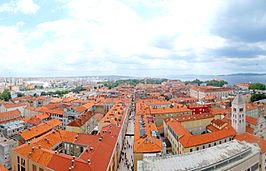
Back ዛዳር Amharic Chadra AN زادار Arabic زادار ARZ Zadar AST Zadar Azerbaijani Задар Byelorussian Задар BE-X-OLD Задар Bulgarian Zadar Breton
Zadar
Zara | |
|---|---|
| Grad Zadar City of Zadar | |
|
Clockwise from top: Panoramic view from Cathedral Bell Tower, University of Zadar, Monument to the Sun, People's Square, St Dominic's Church, Church of St. Donatus and Bishops' palace on the Ancient Roman Forum. | |
 | |
| Coordinates: 44°7′10″N 15°13′55″E / 44.11944°N 15.23194°E | |
| Country | Croatia |
| County | Zadar County |
| Liburni settlement | 9th century BC |
| Roman foundation Colonia Iulia Iader | 48 BC |
| Government | |
| • Mayor | Branko Dukić (HDZ) |
| • City Council | 27 members |
| Area | |
| • City | 192.4 km2 (74.3 sq mi) |
| • Urban | 51.3 km2 (19.8 sq mi) |
| • Metro | 194 km2 (75 sq mi) |
| Population (2021)[2] | |
| • City | 70,779 |
| • Density | 370/km2 (950/sq mi) |
| • Urban | 67,309 |
| • Urban density | 1,300/km2 (3,400/sq mi) |
| Time zone | UTC+1 (CET) |
| • Summer (DST) | UTC+2 (CEST) |
| Postal code | HR-23 000 |
| Area code | +385 23 |
| Vehicle registration | ZD |
| Patron saints | Saint Anastasia Saint Chrysogonus Saint Simeon Saint Zoilus |
| Website | www |
| Official name | Venetian Works of Defence between the 16th and 17th Centuries: Stato da Terra – Western Stato da Mar |
| Criteria | Cultural: iii, iv |
| Reference | 1533 |
| Inscription | 2017 (41st Session) |
| Area | 378.37 ha |
Zadar (US: /ˈzɑːdɑːr/ ZAH-dar,[3][4] Croatian pronunciation: [zâdar] ;[5]; Italian: Zara pronounced [ˈdzaːra], see also other names), is the oldest continuously inhabited city in Croatia. It is situated on the Adriatic Sea, at the northwestern part of Ravni Kotari region. Zadar serves as the seat of Zadar County and of the wider northern Dalmatian region. The city proper covers 25 km2 (9.7 sq mi) with a population of 75,082 in 2011[update], making it the second-largest city of the region of Dalmatia and the fifth-largest city in the country.
Today, Zadar is a historical center of Dalmatia, Zadar County's principal political, cultural, commercial, industrial, educational, and transportation centre. Zadar is also the episcopal see of the Archdiocese of Zadar. Because of its rich heritage, Zadar is today one of the most popular Croatian tourist destinations, named "entertainment center of the Adriatic" by The Times and "Croatia's new capital of cool" by The Guardian.[6]
UNESCO's World Heritage Site list included the fortified city of Zadar as part of the Venetian Works of Defence between the 16th and 17th centuries: Stato da Terra – Western Stato da Mar in 2017.[7]
- ^ Register of spatial units of the State Geodetic Administration of the Republic of Croatia. Wikidata Q119585703.
- ^ "Population by Age and Sex, by Settlements, 2021 Census". Census of Population, Households and Dwellings in 2021. Zagreb: Croatian Bureau of Statistics. 2022.
- ^ "Zadar". The American Heritage Dictionary of the English Language (5th ed.). HarperCollins. Retrieved 23 August 2019.
- ^ "Zadar". Merriam-Webster.com Dictionary. Retrieved 23 August 2019.
- ^ "Zȁdar". Hrvatski jezični portal (in Croatian). Retrieved 17 September 2018.
Zȁdar
- ^ Termin održavanja (7 November 2016). "Destinacije – Zadar – 3000 godina povijesti – Kongresni turizam". Poslovni turizam. Archived from the original on 12 March 2017. Retrieved 9 March 2017.
- ^ "Venetian Works of Defence between the 16th and 17th Centuries: Stato da Terra – Western Stato da Mar". World Heritage Convention. UNESCO. Retrieved 25 March 2024.
© MMXXIII Rich X Search. We shall prevail. All rights reserved. Rich X Search








